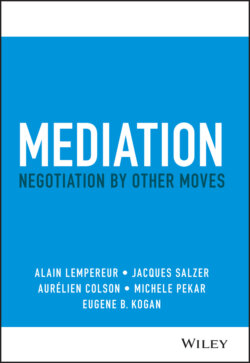Читать книгу Mediation - Alain Lempereur - Страница 43
Communication and Relationship Breakdown
ОглавлениеA parent has not seen their child for 10 years. An owner does not respond to an urgent request from a tenant. A business does not deliver an order despite multiple messages. In every case, one party avoids contact for multiple possible reasons: the fear of blame, aggression, or shaming by the other party; the desire to no longer suffer from (physical or verbal) abuse; the difficulty of fulfilling a contract; the other's rejection; or even a position of strength resulting in denying any demand.
Accepting the presence of a neutral person between oneself and the other constitutes a first step in renewing the dialogue. Sometimes, simply learning that “the other” proposes mediation is perceived as a sign of opening and suffices to relaunch direct negotiations resulting in a solution, without the need for external mediators.
In cases of a complete relationship breakdown, it proves useful to involve a third party, who plays the role of a messenger between the parties. There are two possibilities:
The parties agree to meet one another: The mediator reunites them in joint meetings, except if the choice is made to hold private meetings.
The parties refuse to meet one another but agree to communicate through the mediator: The mediator meets them in turn and engages in “shuttle diplomacy.” By carrying the messages between the parties and giving their own perceptions or suggestions on the evolution of the relationship, the mediator plays the role of a mutual spokesperson. As a result, either the parties change their perceptions of “the other,” and agree to meet, or the process proceeds without any physical meeting.
In the latter case, mediation does not serve to renew the relationship between the parties, but to establish enough contact for the resolution of the problem: the parties do not wish to meet each other; they simply want to resolve the problem. In fact, experience shows that there are four different scenarios, in terms of focus and results, defining a Mediation Matrix (see Table 2.1) that reflects the Responsible Negotiation matrix (Lempereur 2018).
1 Mediation with no progress on the relationship or the solution. In this case, the intervention by an outside authority, like an arbitrator or adjudicator, becomes likely. However, sometimes the conflict has ripened, and even after the mediation ends, parties might resume direct negotiations.
2 Mediation with a solution, but without a relationship. “Problem‐centered mediation” is transactional, i.e. only concerned with the substance of a conflict, but not with the quality of relationships among the parties in dispute. Without building a relationship, however, there is a risk that the solution will be short‐lived.TABLE 2.1 The Mediation MatrixFocus on relationshipYes(3) Relationship‐centered mediation(4) Full potential mediationNo(1) Unsuccessful mediation(2) Problem‐centered mediationNoYesFocus on problem‐solving
3 Mediation with a renewed relationship, but without a solution. Some mediations only aim at restoring relationships between parties, without trying to achieve a resolution of the substantive issues at hand. A “relationship‐centered mediation” is seen as a process of transition so that a direct relationship can resume between parties. This renewed relationship allows the parties to find a solution on their own. A metaphor that could be helpful to clarify this situation is a “jump‐start” cable that a fellow driver uses to help start a stalled car. The person offering the cable is not physically pushing the stalled car, but they are serving as a catalyst that enables you to continue on your own.Corporate relationship and sensitive confidentialityTwo companies in a sensitive technology sector were ready to engage in long and costly litigation proceedings, with an unpredictable outcome. Mediators were able to restart communication between them. As soon as their leaders had renewed the thread of their former relationship, they asked mediators to withdraw in order to broach highly confidential questions. In the absence of mediators, the parties drafted a final contract that contained some clauses known only to them.
4 Mediation with a relationship and a solution. This is mediation that delivers its full potential in terms of relationship building and problem‐solving; it yields both relational and transactional results. Though it may look like an ideal to achieve, parties may wish to renounce it when there is already a solution to the problem or a resumption of relationship. So much the better if mediation succeeds in these two spheres of action; but both the parties and the mediator will remember that sometimes there can be a solution without relationship; and the converse. A renewed relationship is like the cherry on top, but the second scenario, whatever discomfort it brings, can emerge, even if the hope was to purge the past and to reconstruct a common future together. Maybe the only future that comes out of mediation is the one, limited but important, that stems from the implementation of a workable solution to a particular problem.
